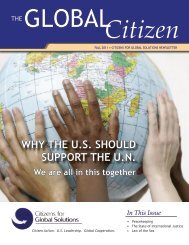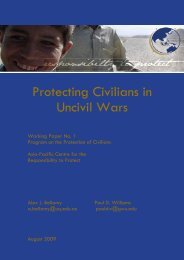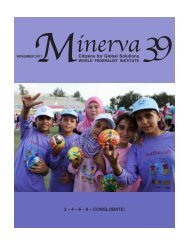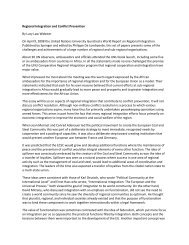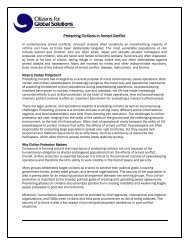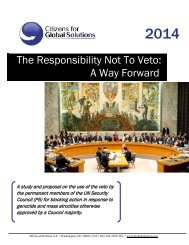Minerva, Spring 2008 (Volume 32) - Citizens for Global Solutions
Minerva, Spring 2008 (Volume 32) - Citizens for Global Solutions
Minerva, Spring 2008 (Volume 32) - Citizens for Global Solutions
You also want an ePaper? Increase the reach of your titles
YUMPU automatically turns print PDFs into web optimized ePapers that Google loves.
1) Participation of women in peace and security initiatives including peace<br />
processes,<br />
2) Inclusion of gender training <strong>for</strong> peace operations,<br />
3) Protection of women and girls and promotion of their rights in armed conflict<br />
and in post-conflict situations and<br />
4) Gender mainstreaming throughout relevant programmes related to conflict,<br />
peace and security. 29<br />
Progress in actually implementing Resolution 1<strong>32</strong>5 has been uneven and can probably<br />
only be meaningfully evaluated within a long-term framework. However, it is patently<br />
clear that precious little has been done about the meaningful “protection of women and<br />
girls and promotion of their rights in armed conflict”. Within the context of the responsibility<br />
to protect, this should be a top priority of all women leaders.<br />
At a broader policy level, there are two strategies that women leaders and advocates<br />
can adopt in order to advance the responsibility to protect. First, they can work to incorporate<br />
the concept into existing work programmes focused on women, peace and<br />
security.<br />
The responsibility to protect provides an important complement to existing commitments<br />
to protect women’s rights and security. Early consultations on the responsibility<br />
to protect highlighted the need <strong>for</strong> women’s groups and women leaders to become<br />
more engaged. For example, following a series of consultations across Africa, Project<br />
Ploughshares found that:<br />
The disproportionate burdens borne by women in armed conflict, the fundamental<br />
role of women in traditional African mechanisms of conflict resolution,<br />
and the urgent need <strong>for</strong> women to be much better represented in positions<br />
of authority are widely recognized as foundational truths that must be<br />
acknowledged in Africa’s new peace and security architecture. Yet women are<br />
consistently underrepresented in <strong>for</strong>a where grand decisions around peace and<br />
security are made. 30<br />
The focus on the protection of populations at risk as well as the inclusion of crimes<br />
against humanity in the threshold criteria of the responsibility to protect have been<br />
welcomed by advocates of this agenda. The government of Canada, speaking to the<br />
Security Council on behalf of the Human Security Network in 2005, illustrated the<br />
linkages between the responsibility to protect and all programmes aimed at preventing<br />
and combating gender-based violence:<br />
. . . [T]he Network welcomes the recent adoption of the principle of the Responsibility<br />
to Protect by world leaders in the World Summit Outcome. We<br />
were particularly pleased that the threshold <strong>for</strong> action that was endorsed is<br />
an inclusive one, in that it holds not only genocide and war crimes but also<br />
crimes against humanity as a key trigger <strong>for</strong> action. The definition of crimes<br />
against humanity includes all of the most egregious examples of gender-based<br />
violence — the horrific results of which we have seen in too many conflict<br />
areas. … In particular, a rigorous monitoring and reporting mechanism <strong>for</strong><br />
gender-based violence will be essential to ensure that states shoulder their<br />
responsibility to not only prevent such violence but also to protect their own<br />
citizens from such crimes. 31<br />
In a similar vein, the World Federalist Movement through its Civil Society Network<br />
calls on organizations focused on women, peace and security to view the responsibility<br />
to protect and Resolution 1<strong>32</strong>5 together, as mutually rein<strong>for</strong>cing commitments by<br />
governments toward preventing and stopping mass atrocities including international<br />
crimes against women and children.*<br />
21 • <strong>Minerva</strong> #<strong>32</strong> • June <strong>2008</strong><br />
Footnotes 29–31:<br />
29 See Jennifer Bond and Laurel Sharret,<br />
A Sight For Sore Eyes: Bringing<br />
Gender Vision to the Responsibility to<br />
Protect Framework (INSTRAW, October<br />
2005).<br />
30 Greg Puley, The Responsibility to<br />
Protect: East, West and Southern African<br />
Perspectives on Preventing and Responding<br />
to Humanitarian Crises, Working<br />
Paper (Waterloo: Project Ploughshares,<br />
2005), 25.<br />
31 Security Council Open Debate on<br />
Women, Peace and Security, 27 October<br />
2005.<br />
* [See next page]



